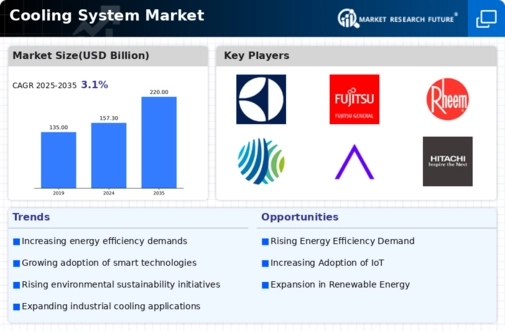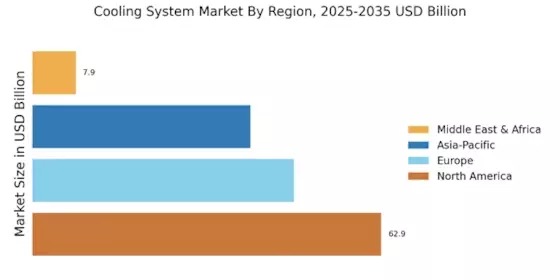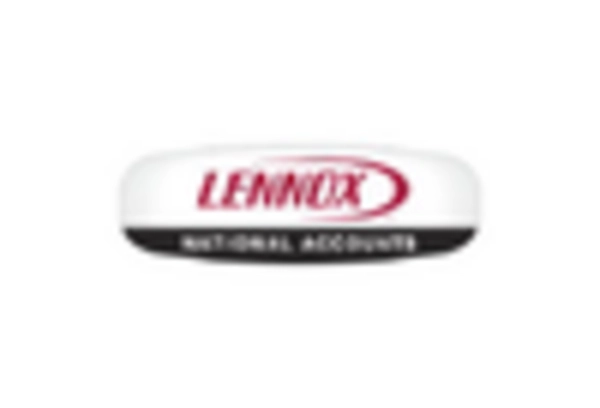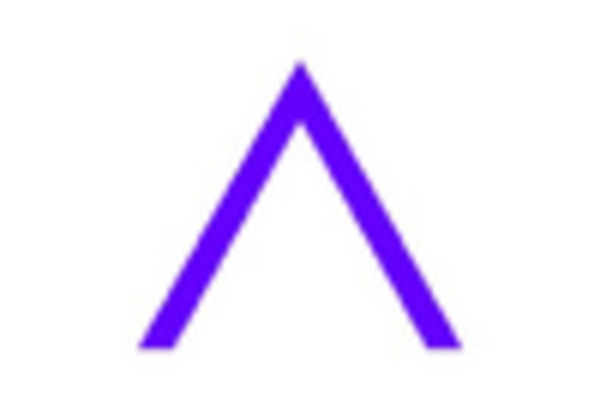Increased Focus on Indoor Air Quality
The growing awareness of indoor air quality (IAQ) is emerging as a vital driver in the Cooling System Market. Consumers are increasingly concerned about the health implications of poor air quality, leading to a demand for cooling systems that not only cool but also purify the air. Advanced filtration technologies and air purification features are becoming standard in modern cooling systems. Market Research Future indicates that systems equipped with air quality monitoring and filtration capabilities are gaining traction among consumers. This trend is likely to influence manufacturers to prioritize IAQ in their product offerings, thereby enhancing the overall appeal of cooling systems. The emphasis on indoor air quality is reshaping the Cooling System Market, as stakeholders recognize the importance of health and comfort.
Growing Urbanization and Population Density
Urbanization is a significant driver influencing the Cooling System Market. As populations migrate towards urban areas, the demand for effective cooling solutions escalates. High-density living environments, such as apartments and commercial buildings, require efficient cooling systems to maintain comfort levels. Data suggests that urban areas are experiencing a rise in temperature, further amplifying the need for reliable cooling solutions. This trend is particularly evident in regions with extreme climates, where cooling systems are essential for daily living. Consequently, manufacturers are focusing on developing compact and efficient cooling systems tailored for urban settings. The interplay between urbanization and the Cooling System Market is likely to foster innovation and growth in the sector.
Regulatory Support for Sustainable Practices
Regulatory frameworks promoting sustainability are significantly impacting the Cooling System Market. Governments worldwide are implementing stringent regulations aimed at reducing greenhouse gas emissions and encouraging the adoption of eco-friendly technologies. These regulations often include incentives for consumers to invest in energy-efficient cooling systems. As a result, manufacturers are compelled to innovate and align their products with these regulations, leading to the development of more sustainable cooling solutions. Market data indicates that regions with robust regulatory support are witnessing a faster adoption of advanced cooling technologies. This regulatory environment is likely to drive growth in the Cooling System Market, as stakeholders adapt to meet evolving standards and consumer expectations.
Rising Demand for Energy-Efficient Solutions
The increasing emphasis on energy efficiency is a pivotal driver in the Cooling System Market. As consumers and businesses alike seek to reduce energy consumption and lower utility bills, the demand for energy-efficient cooling systems has surged. According to recent data, energy-efficient cooling systems can reduce energy use by up to 50% compared to traditional systems. This trend is further fueled by government regulations and incentives aimed at promoting sustainable practices. Consequently, manufacturers are innovating to develop advanced cooling technologies that not only meet but exceed energy efficiency standards. This shift towards energy-efficient solutions is likely to reshape the Cooling System Market, as stakeholders prioritize sustainability and cost-effectiveness.
Technological Advancements in Cooling Systems
Technological innovation plays a crucial role in driving the Cooling System Market forward. The advent of smart technologies, such as IoT-enabled cooling systems, has transformed how consumers interact with their cooling solutions. These systems offer enhanced control, allowing users to monitor and adjust settings remotely, thereby optimizing energy use. Furthermore, advancements in refrigerants and materials have led to the development of more efficient and environmentally friendly cooling systems. Market data indicates that the integration of these technologies is expected to increase system efficiency by approximately 30%. As a result, the Cooling System Market is witnessing a shift towards more sophisticated and user-friendly solutions, catering to the evolving needs of consumers.


















Leave a Comment